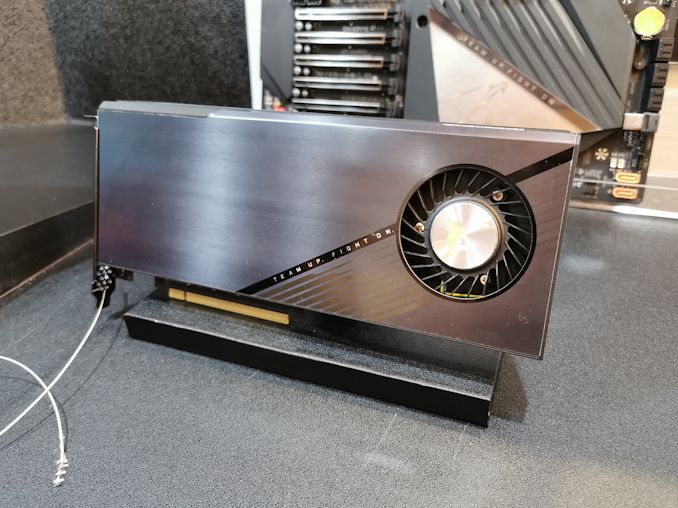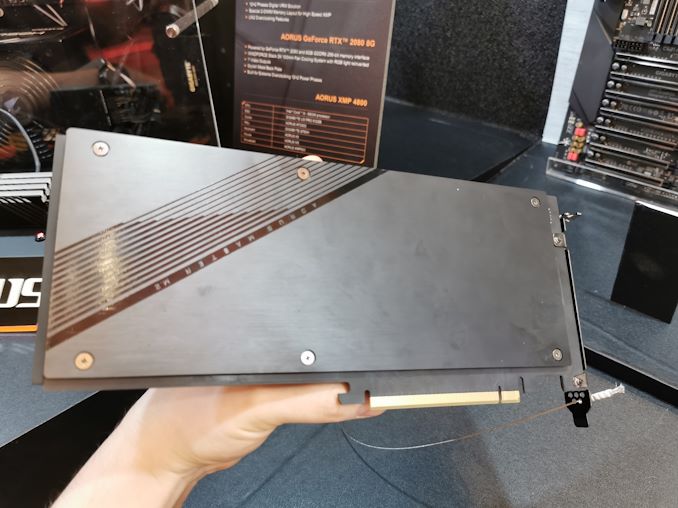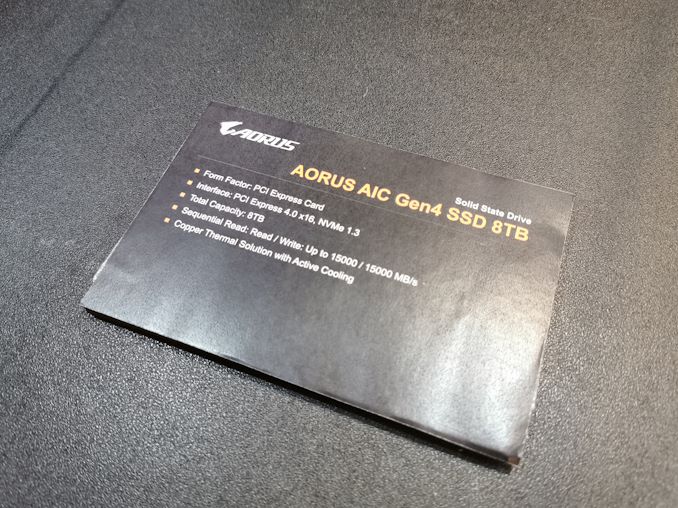GIGABYTE Shows PCIe 4.0 x16 Four-Way M.2 PCIe Add-In Card
by Ian Cutress on May 29, 2019 3:00 PM EST- Posted in
- SSDs
- Gigabyte
- Trade Shows
- Phison
- M.2
- PCIe
- PCIe 4.0
- Computex 2019

We’ve seen some of these before – an add-in card that helps expand the M.2 capabilities of a system. Typically motherboards come with up to three M.2 slots, however the high-end desktop market might need more than this, and with plenty of PCIe lanes to spare, for those that need it, extra add-in card based storage is vital. In the last generation of products, we saw a number of motherboard OEMs launch PCIe 3.0 based designs, offering another two or four M.2 slots. GIGABYTE the first company we’ve seen with a four-way design for PCIe 4.0.
The card takes a PCIe 4.0 x16 slot (can be run at PCIe 3.0 mode, for what it’s worth), and branches out into four PCIe 4.0 M.2 slots. No extra power is needed – it takes up to 75W from the socket, although it’s unlikely that four M.2 SSDs will draw more than 32W. The shroud has a fan to assist cooling, however the metal casing acts as a top and bottom heatsink.
Ultimately the only systems that can support PCIe 4.0 right now will be Ryzen 3000, but it’s unlikely that system users there will dedicate all of the x16 lanes for the GPU to extra storage. In that case, we have to look to future Threadripper parts that are likely PCIe 4.0 enabled. When asked, GIGABYTE said that this expansion card is aimed at AMD machines, mostly because of a lack of proper feature support on Intel systems.
| Want to keep up to date with all of our Computex 2019 Coverage? | ||||||
 Laptops |
 Hardware |
 Chips |
||||
| Follow AnandTech's breaking news here! | ||||||












9 Comments
View All Comments
ToTTenTranz - Wednesday, May 29, 2019 - link
Does the Ryzen 3000 with a X570 support VROC?I thought AMD only enabled it on the Threadripper platform, in X399 motherboards.
Mikewind Dale - Wednesday, May 29, 2019 - link
Does it support M.2 22110 SSDs with power loss capacitors? Or does the card itself have integrated power-loss capacitors?Also, it would be interesting to see what happens when this card is plugged into a x8 PCIe slot. Graphics cards are already not using the full bandwidth of a PCIe 3.0 x16 slot, so I imagine that installing this on a Ryzen with a 4.0 x16 and forcing it to 4.0 x8 wouldn't cause any performance loss on the graphics side. Now, on the SSD side, you'd be forcing your 4 M.2 SSDs from 4.0 x16 down to 4.0 x8, but that's still the same bandwidth as 3.0 x16. So ultimately, if you install this on a Ryzen X570 board, you might get the same performance as contemporary PCIe 3.0 SSDs, which is not bad at all. I'd like to see some benchmarks.
Mikewind Dale - Wednesday, May 29, 2019 - link
(Note that I am assuming a PCIe 4.0 GPU like the Navi, and PCIe 4.0 SSDs.)bronan - Sunday, August 25, 2019 - link
This far there are not really any pci-e 4.0 cards and if they get released they probably will not need more that pci-e 2 x8 speeds to work. It would be a huge surprise if someone can show me that his videocard ( non server based card ) actually needs a faster speed than pci-e x8 ...Skeptical123 - Wednesday, May 29, 2019 - link
Idk but I guess it will not have power loss capacitors because I have not seen such implementations on consumer/enthusiast cards only server stuff.This is not the case " Now, on the SSD side, you'd be forcing your 4 M.2 SSDs from 4.0 x16 down to 4.0 x8, but that's still the same bandwidth as 3.0 x16. So ultimately, if you install this on a Ryzen X570 board, you might get the same performance as contemporary PCIe 3.0 SSDs," It's important to keep in mind this card wires 4 pcie lanes to each M.2 drive from the CPU. If you use the card in a 8x instead of a 16x slot you will either get 2 PCIe lanes instead of 4 greatly reducing drive speed or only 2 not 4 drive slots will work. It depends on pcb layout. Cards like this are not able to load balance to use all the available band with. That is only possible for cards that have a multiplexer chip which unless stated I highly doubt it has.
lightningz71 - Thursday, May 30, 2019 - link
Wait, does that mean that Ryzen 3K supports 4X bifurcation of the PCIe 4.0 X16 channel that's dedicated to the first PCIe slot (or first two)?supremelaw - Monday, June 3, 2019 - link
> does that mean that Ryzen 3K supports 4X bifurcation of the PCIe 4.0 X16 channel that's dedicated to the first PCIe slot (or first two)?Yes and No.
Yes, because each of the four x4 subsets is dedicated to a single NVMe x4 M.2 SSD,
and the BIOS needs to treat each M.2 as if it were plugged into an integrated M.2 port.
This approach eliminates the need for a dedicated PLX-type switch, and
the absence of a PLX-type switch is probably the reason why devices like
the ASRock Ultra Quad M.2 add-in card is much less expensive than a
similar AIC from Highpoint.
ASRock uses the nomenclature "4x4"; ASUS uses "x4x4x4x" in their nomenclature:
https://www.anandtech.com/show/12324/asrock-at-ces...
> dedicated to the first PCIe slot (or first two)?
Maybe not, because the reports from Computex are pretty sparse on implementation details e.g.
there has been talk that the 16G clock in the PCIe 4.0 spec needs a short trace,
which implies the first PCIe 4.0 slot ONLY.
AMD will need to open up about any such limitations; otherwise, they can expect
customer support complaints that these PCIe 4.0 AICs just don't work in the
lower PCIe x16 expansion slots, or they are running slower than expected
because the BIOS has down-clocked each x1 lane to 8 GHz.
I can foresee certain such problems chiefly because so many prosumers are
already habituated to installing a single GPU in the first x16 expansion slot.
We've been installing a PCIe 2.0 RAID controller in the first x16 expansion slot
on our aging backup storage servers, and this usually means we must live
with a video card running slower in a lower PCIe expansion slots (because
the BIOS assigns only x4 "logical" PCIe lanes to such video cards). But,
that's a very small sacrifice to pay with backup storage servers that
never need really fast graphics.
Ideally, future engineering innovations will permit "4x4" bifurcation
of all x16 PCIe 4.0 and PCIe 5.0 expansion slots, no matter how far UP
or how far DOWN those slots are situated on a motherboard.
In the main, I'm delighted that the computer hardware manufacturers
have now seen the crucial importance of upstream bandwidth,
and of direct-CPU lanes that are not downstream of Intel's
DMI bottleneck.
Hope this helps.
p.s. If I've made any mistakes above, please speak up:
we are entering a new era with PCIe 4.0, and it's truly exciting
for what it makes possible with solid-state storage devices.
Tomyknee - Tuesday, September 3, 2019 - link
Supreme, perhaps you know. I am looking at the Asus WS 570-Ace which has a PLX chip so its three PCIe 4.0 slots can run at 16x or (x8x8x8). I hate that it only has one M.2 x4 (to CP) and the other is M.2 x 2x)1) Would a PCIe 4.0 card with 2 M.2's run at M.2 x 4x?
2) Am I really not taking much of a 'hit' if I run a PCIe 4 GPU at 8x?
bronan - Sunday, August 25, 2019 - link
I have been asking myself the same questions regarding in what system this card can get its max performance. As i see it these cards should probably run best into a thread ripper machine.But since these are not pci-e 4.0 the card would switch back to pci-e 3.0, however if i wonder if the hardware can work with these insane speeds well. The theoretical speed when at full capacity would be 128 gbps. In pci-e 4.0 mode that would become 256 gbps.
But i read from other experimenting with these boards that somehow these boards are not able to get to full speed because of the limitations from the pci-e lanes handled on pci-e slots and second the limitation from cpu's. This far i have not seen real live tests of these cards into either 3000 series or threadripper boards.
Regarding gpu's i never seen a videocard needing more than really pci-e 2.0 x8 even though all are sold for the newest slots they actually seem never to use more than that ever.
If i am wrong about that please show me some link that proves you can get the max possible speed on these cards. this far i only detected that people which do have these expansion cards detected all kinda issues that prevented the cards to really show their muscles.
Intel based motherboards suffer from the fact that even though you have a pci-e x16 slot card the system handles each lane as a x4 but as far as i know hardly any gamer motherboard supports the x4/x4/x4/x4 options in the bios.
This far those options are often only found on server boards and high end amd boards (thread ripper).
Anyway would like to run a 4 x nvme board but i am pretty sure it probably get limited on consumer boards when you add 4 nvme ssd's into it.
I also like to say that the current pci-e 4.0 ssd are faster but for me are in my view not really going to change anything for gamers.
I have actually 2 x samsung 970 evo 1 TB ssd's and actually was stunned that my old samsung MZ7 sata ssd's in raid 0 load my games and saves much faster than both the nvme ssd's in raid 0.
Only at specific tasks i see some gain in speed, but overall the nvme drives are often slower than the old sata ssd's. So to be honest if your smart try to get your hands on second hand enterprise ssd's and put them into a raid 0 and use them for your games. You will see a nice boost in speed with loading games and saves